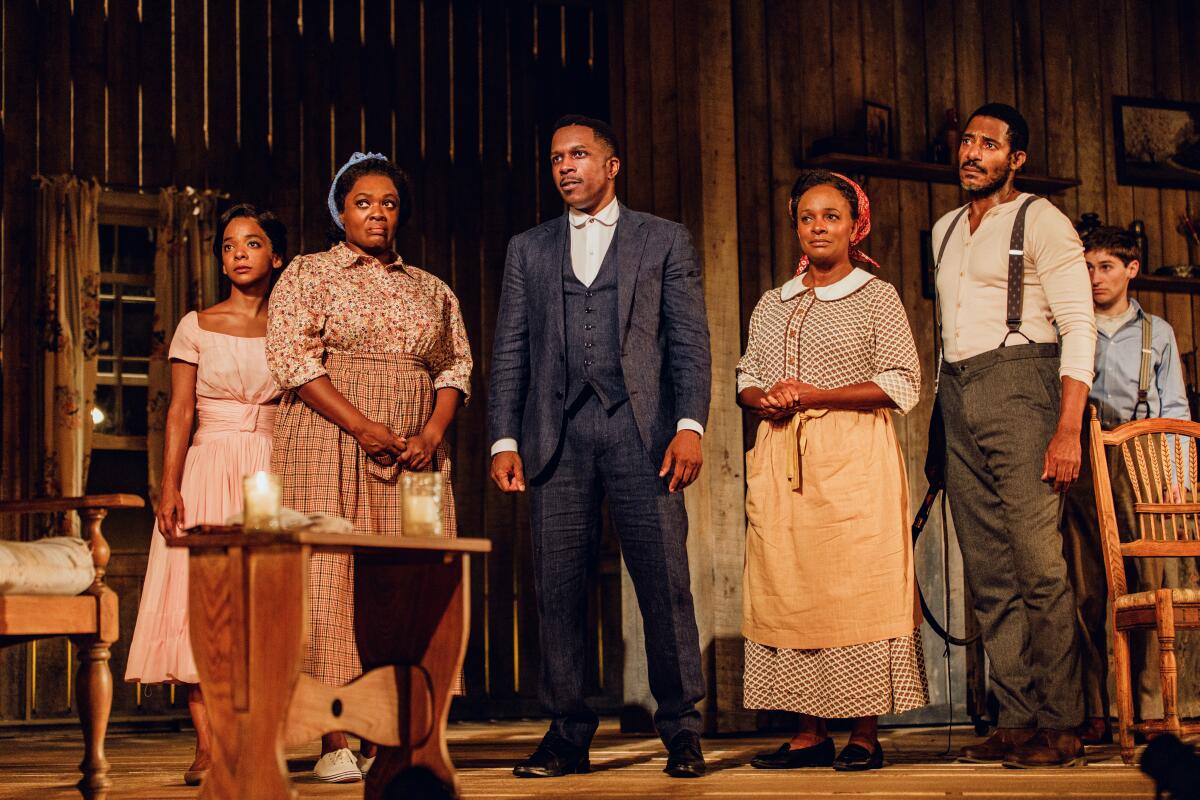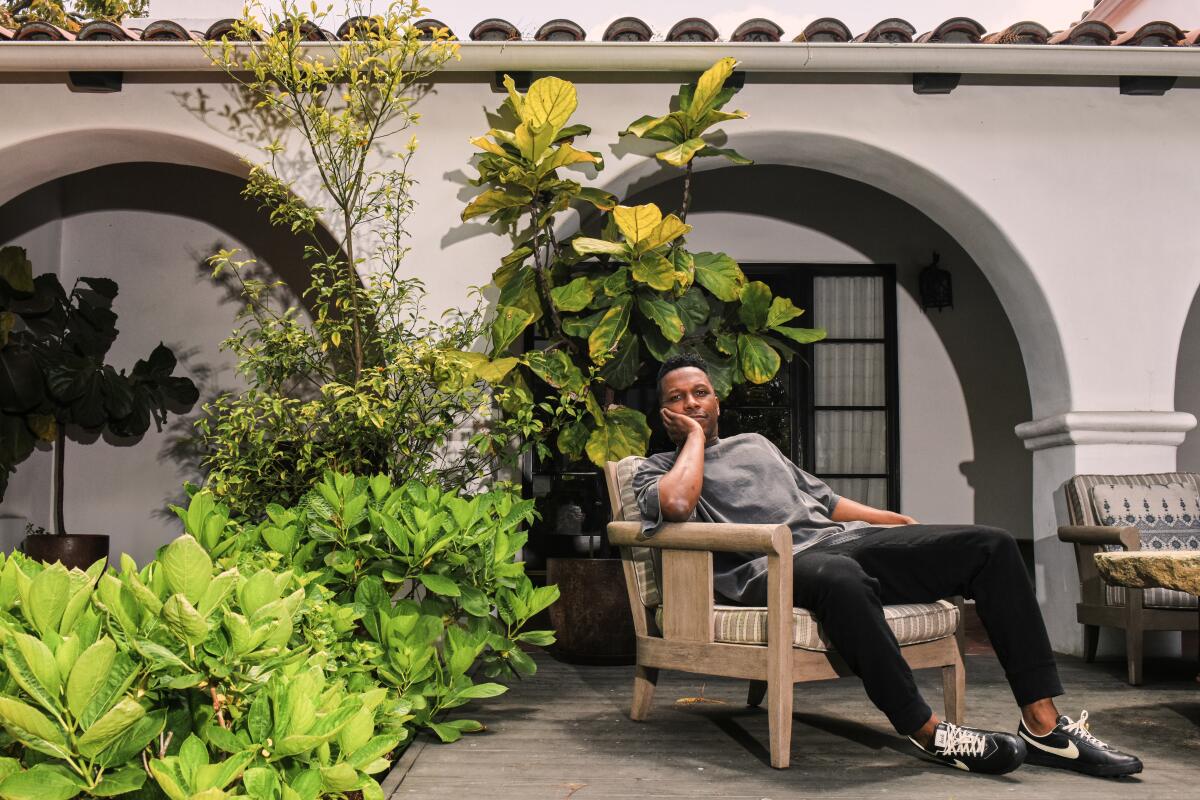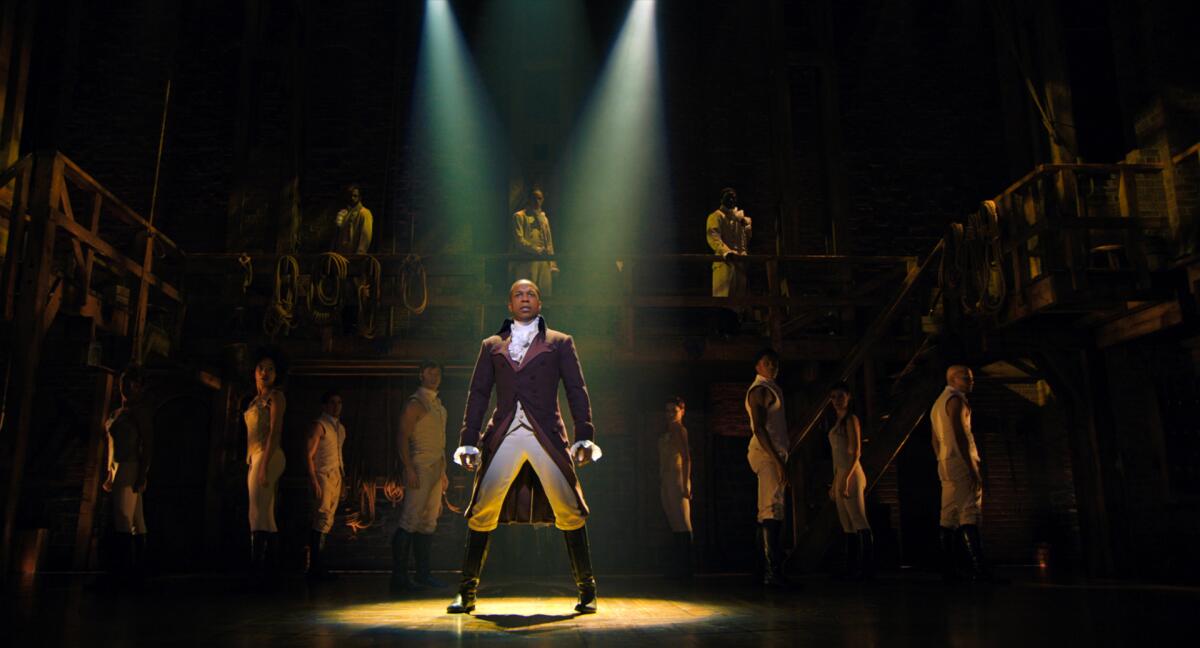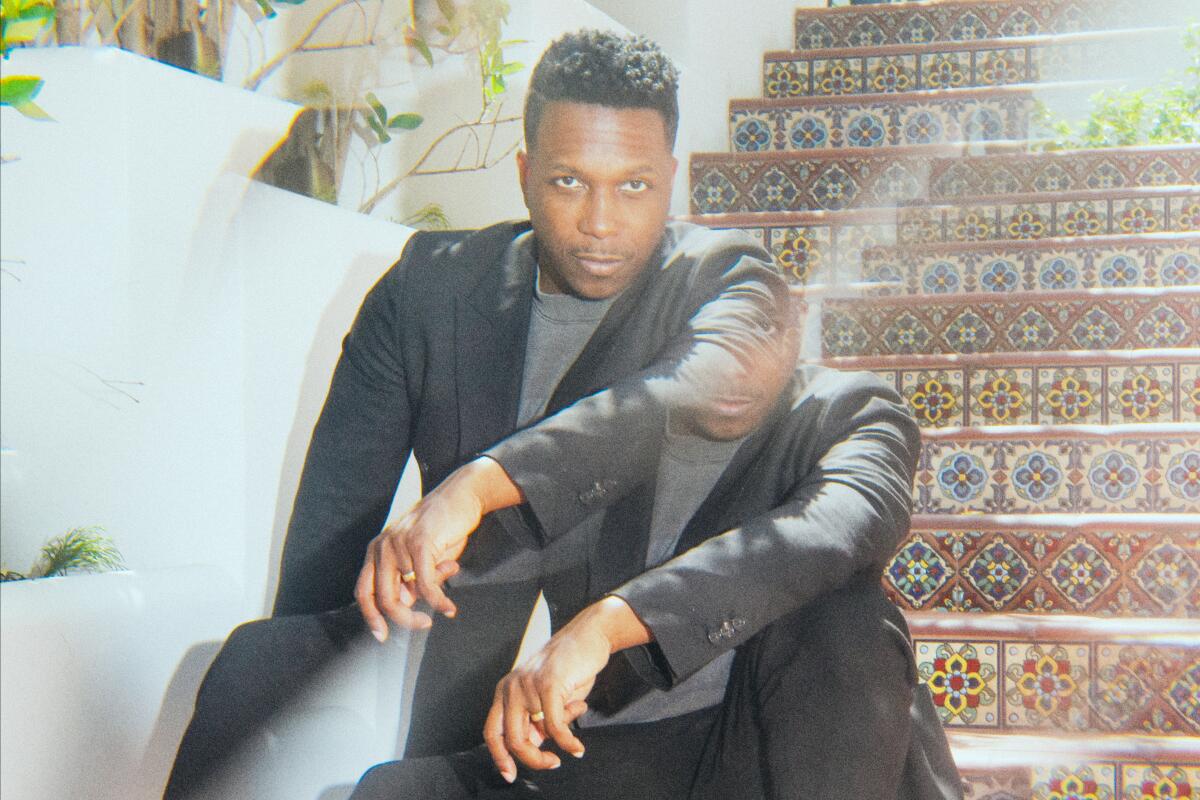Leslie Odom Jr. produced and starred in the Broadway revival of “Purlie Victorious,” which just got six Tony nominations and soon premieres on PBS.
(Irvin Rivera / For The Times)
It’s been three months since Leslie Odom Jr. last preached and schemed in “Purlie Victorious: A Non-Confederate Romp Through the Cotton Patch,” a project he’d been plotting since the 2016 night he won the Tony for his performance as Aaron Burr in “Hamilton.”
The Broadway revival of Ossie Davis’ high-octane farce starred Odom as the titular traveling minister who returns to southern Georgia to free his family, buy his old plantation master’s barn and turn it into a racially integrated church — a plan pulled off with indignant monologues, satirical punchlines and plenty of physical comedy. Directed by Kenny Leon, the play’s first commercial production in six decades earned six Tony Award nominations, including for Odom’s performance; a filmed version premieres Friday on PBS, as part of its Great Performances series.
“It’s the most demanding role I’ve ever done,” Odom told The Times. “I was possessed by the idea and the inspiration for so long, it was so clear and important and the center of my creative life for years. Letting go of an intense project like that can be a little rudderless, a little unmoored.”
“Purlie Victorious” is also Odom’s debut as a Broadway producer — a role he took as seriously as that of Purlie himself, especially given the struggles many plays now face in finding an audience. Seated in the living room of his Los Angeles home, his Grammy and Tony trophies among his children’s toys and photos with his wife, Nicolette Robinson, Odom discussed the choice to put on “Purlie Victorious” as a play and not a musical, the challenges of being a first-time producer and why the production was extended even though it didn’t recoup its initial investment. This conversation has been edited for clarity and length.
When did you first encounter this play?
I was 15 or 16. It was a big part, with some big speeches. And that’s what I was interested in as a young actor — like, how much can I use this highlighter?
You’ve said you’ve recited its passages in auditions. Did they get you any roles?
[Laughs.] No. It was back in the day. I didn’t know what I was doing with those then.
“Purlie Victorious” later became a stage musical. Did you ever consider pursuing that show, given your musical expertise?
We were initially inquiring — a couple times a year, every year — about the musical, not the play, but a producer who held the rights to the entire property wasn’t interested. When the rights became available in 2021, we got in conversations with the estate — Ossie and Ruby [Dee]’s three children — and they would only give us permission to do the play, because the musical is an adaptation, an edit, a reimagining of their father’s play. They were very interested in their dad’s words unedited and unfiltered.
We said yes because, if we were ever going to do the musical eventually, this was gonna be the first step. I sort of thought, “We’ll start doing the play, and then they’ll realize that we really should be doing the musical.” But they were so right. I’m so grateful to them for sticking to their guns and drawing that line, because we found how much music was there in the script itself, in the rhythms and the poetry and the rhyme of the dialogue. And we also saw just how beautifully the piece met this moment in time, after things came to a head in so many ways in 2020.

Kara Young, Heather Alicia Simms, Leslie Odom Jr., Vanessa Bell Calloway, Billy Eugene Jones and Noah Robbins in the Broadway revival of “Purlie Victorious.”
(Marc J. Franklin)
Were you nervous to return to Broadway with a straight play, versus a musical?
Very nervous. And yet, I didn’t know how much I needed it — how much I needed to challenge myself to hold center stage without melody, without the benefit of Andy Blankenbuehler’s choreography. There’s a vulnerability when there’s no distraction. It was an opportunity to come back to New York and to the theater and risk something, to see if I’d grown and learned anything in these years since they saw me last.
It’s your first time producing a Broadway show. What was the hardest part, especially while also performing?
The compartmentalization was tricky. When a fellow actor is coming to you with concerns, sometimes they need you to hear them just as a scene partner and not as anything else. When a producer is telling you about something that concerns the production, they need to talk to you as a producer and not as the lead actor. So the compartmentalization was tricky. There were times where I would say to [my fellow producers] Jeffrey [Richards] and Hunter [Arnold] and Nicolette [Robinson], “I’ve just got to be an actor right now, I need you to keep your eye on this thing.”
I don’t think I’ve ever been more aware of the places within me that needed shoring up than the day we got a Broadway theater. [Roundabout Theatre Company’s late artistic director] Todd Haimes gave us a theater in the season before this one. But I was shooting another thing, and I just didn’t feel confident about doing the role and producing at the same time; I didn’t feel I could yet lead in the way that I wanted to lead. It was important that the production felt seminal and worthy of the piece, that the experience be as edifying and healing as it could be for everybody involved, and that my insecurities and my worry didn’t tank the experiences for my collaborators.
Jeffrey and I had a really challenging conversation, and we let that theater go. And that’s hard, because you don’t know if it’s gonna come back. I certainly wasn’t doing it to burn bridges, but it was the decision we needed to make. I’m so glad we did.

(Irvin Rivera / For The Times)
As this is also your first time starring in a Broadway production, what did you want to do as a leader, on or offstage?
I started on Broadway as a replacement in the ensemble. To then be in an original Broadway cast that was a total failure and then to do a Broadway hit, what I was able to see as a “star” is it is your responsibility to keep the doors open. I can’t tell you how often I’ve seen “stars” who believe that shows should be mounted and kept running because of how wonderful and brilliant they are. That’s what I saw coming up, and I thought, “If ever I’m given the opportunity, that’s not going to be me.”
I understand that when a production is mounted with my face on the poster, it is my job to do my best onstage, but that’s not where the job ends. It’s also my job to do press, to [meet fans at the] stage door, to gather with an online community — for the good of this whole production. It’s also my job to help create an environment where the best idea really does win and where people feel appreciated and valued enough to share their idea because it won’t get stolen by someone else.
I told myself I’m not going to be the guy who only takes. It’s also about how much I can give, and it’s going to come from a pure place.
A lot of plays don’t earn back their capitalization. Did this production recoup its full investment?
No, it did not.
The original “Purlie Victorious” didn’t either, yet was extended multiple times. Why extend the revival by a month, even after other plays had to close early?
I was probably one of the people who looked only at box office returns — and they are important — before Kenny gave me an education on this. He said, “You have to understand: If these theater owners only cared about dollars and cents, there’d be a movie musical in every one of these houses. That’s not all that they care about, and thank goodness. Plays still matter to the health of Broadway as a whole. They mean something, they say something about the seriousness of the theater and the seriousness with which we take the theater.”
We did quite well, considering what we were up against. There are plays that have been raised to a lofty place in the American theater canon, where we get a production every couple of years and we’re thankful every time. I’ve seen two “Uncle Vanyas” this year, you know what I mean? “Purlie Victorious” is not one of those plays. People don’t have a connection to this title. And while I certainly hope that my star power can grow to the point that when I’m a part of something, that my name alone is enough to buy a ticket, I’m still building that trust with an audience.
We were able to strategically make it so that “Purlie Victorious” was an affordable ticket to schools and groups from all around the city — and even my hometown of Philadelphia only two hours away — while somehow still keeping our average ticket price above $100, which was super important for the health of the production. We heard early from Bob Wankel, the chairman of the Shubert Organization, about the diversity of our audiences: “Purlie Victorious” was one of those shows that reached far and wide, and the people it’s getting into the door are good for the health of the whole theater community. So it was successful in ways that we hoped it would be and in ways that we never imagined it could be.
Numerous Black plays have opened on Broadway since the pandemic, but that number has lessened with each subsequent season. Why do you think that is?
There’s probably lots of reasons. I’m not talking about any production in particular, but for any underrepresented group, our responsibility — the thing that makes me lose sleep, the thing that keeps me on the therapist’s couch, the thing that I’m journaling about — is to make sure we’re doing everything we can to meet the standard, every single time we’re up at bat. Because anytime we come up short, the consequences are wide-ranging. They don’t just affect you. They affect the people behind you; we risk their opportunities.
Meet the moment with excellence, that’s all we can do. It’s not easy, but it is worth it, to demand that of ourselves. We will continue to get moments, to get looks, to get chances at bat. And so, best to hold off for one more season, go back to the drawing board, go back into the workshop phase — best to do all those things while you get it right.
How many performances were filmed for the broadcast?
Four, toward the end of the run. Plus a day of pickups [with no audience for close-up shots] — something else I learned from “Hamilton.”

Leslie Odom Jr., shown in the filmed version of “Hamilton,” won a Tony for his performance as Aaron Burr in the original Broadway production.
(Disney+)
Tell me about opening the broadcast with not just Kenny’s audio greeting and footage of the audience settling in, but also a lingering, zoomed-in shot of Ol’ Cap’n Cotchipee’s whip onstage.
Kara [Young, who played Lutiebelle] was hard on us as a company about that whip. We were deep into previews when she said to us, “We’re still treating this like a prop. This is a torture device that has been handed down from generation to generation. Who in your family suffered at the hands of this thing?” It was hard to open those doors; the underpinnings of this show are painful and serious.
At our last rehearsal onstage, I went to Jay [O. Sanders, who plays Ol’ Cap’n Cotchipee]. He was our villain, so as a producer, I wanted him to feel accepted and part of the company. But as an actor playing Purlie, I said to him, “I’m not hating you in the way that I should.” Hate is disfiguring; it doesn’t feel good to remind yourself to treat a person in a way to honor the tragic history. I had to give myself that permission and make peace with Jay to allow Purlie his hate, all for him to come out of it in the way we needed to in order for the show to work.
You land lots of satirical jokes that get big audience reactions — even from white theatergoers. Which was your favorite?
My favorite line in the whole piece was in that final scene in the church. [Purlie tells the congregation and the audience,] “Farewell, my deep and Africanic brothers. Be brave; keep freedom in the family; do what you can for the white folks; and write me in care of the post office.”
That is as slick and as bold as anything I’ve heard Kendrick [Lamar] say in this battle, or anything I’ve heard Kanye [West] say in one of his lucid moments. It’s biting satire, it’s daring and bold and dangerous and funny, brilliantly balancing the moral and intellectual high ground with the irony and the audacity that this character, after everything he’s gone through, could potentially be the patronizing one for a moment. He was a hip-hop MC confidently occupying a throne in a church on a remote farm, even on the last page of the play.
What excites you about this revival being preserved and airing on TV?
We were the first commercial production of the play in decades, but I certainly hope we’re not the last. And the preservation of what we made as a company means that the high schools, the colleges, the regional theaters get to start with that and build on it, if they choose. When I left “Hamilton,” I knew guys were gonna come in and probably be a better Burr than I was because they had the benefits of seeing what I couldn’t see when I was in it. They could fill in what I missed. So I’m excited to go see a production of “Purlie Victorious” somewhere, to see actors make me laugh and break my heart in ways I didn’t know was possible.
With the play done, would you ever produce and/or perform in the “Purlie” musical?
I would love to, and I’m having those conversations with a couple of people. We will see. I think Ossie Davis is still saying something powerful to this generation about the unfiltered, unedited Black voice, Black imagination, Black humor, Black genius. So if he is still speaking to us, I want to be a part of it.

(Irvin Rivera / For The Times)
‘Purlie Victorious: A Non-Confederate Romp Through the Cotton Patch’
Where: PBS, pbs.org/gperf and the PBS App
When: Anytime, starting at 9 p.m. Friday, May 24. Available to stream through July 19
Running time: 1 hour, 45 minutes


